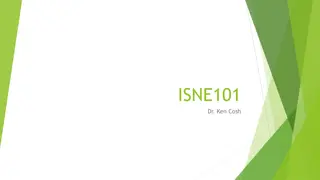Understanding Software Processes and Models
This lecture discusses software processes, models, and activities involved in requirements engineering, software development, testing, and evolution. It covers topics such as process models, computer-aided software engineering (CASE) technology, software specification, design, validation, and evolution. The software process is described as a structured set of activities required for developing a software system, with an abstract representation provided by a software process model. The lecture also delves into the requirements engineering process, software design and implementation, and design process activities.
Download Presentation

Please find below an Image/Link to download the presentation.
The content on the website is provided AS IS for your information and personal use only. It may not be sold, licensed, or shared on other websites without obtaining consent from the author. Download presentation by click this link. If you encounter any issues during the download, it is possible that the publisher has removed the file from their server.
E N D
Presentation Transcript
LECTURE 2 SOFTWARE PROCESSES 1
OBJECTIVES To describe outline process models for requirements engineering, software development, testing and evolution To introduce CASE technology to support software process activities 2
TOPICSCOVERED Process activities Computer-aided software engineering CH4 starting from p.74 3
THESOFTWAREPROCESS A structured set of activities required to develop a software system A software process model is an abstract representation of a process. It presents a description of a process from some particular perspective. 4
PROCESSACTIVITIES Software specification Software design and implementation Software validation Software evolution 1. 2. 3. 4. 5
SOFTWARESPECIFICATION The process of establishing what services are required and the constraints on the system s operation and development. Requirements engineering process Feasibility study; Requirements elicitation and analysis; Requirements specification; Requirements validation. 1. 2. 3. 4. 6
SOFTWAREDESIGNAND IMPLEMENTATION The process of converting the system specification into an executable system. Software design Design a software structure that realises the specification; Implementation Translate this structure into an executable program; The activities of design and implementation are closely related and may be inter-leaved. 8
DESIGNPROCESSACTIVITIES Architectural design Abstract specification Interface design Component design Data structure design Algorithm design 1. 2. 3. 4. 5. 6. 9
STRUCTUREDMETHODS Systematic approaches to developing a software design. The design is usually documented as a set of graphical models. Possible models Object model; Sequence model; State transition model; Structural model; Data-flow model. Will be covered in chapters 10, 14 11
PROGRAMMINGANDDEBUGGING Translating a design into a program and removing errors from that program. Programming is a personal activity - there is no generic programming process. Programmers carry out some program testing to discover faults in the program and remove these faults in the debugging process. 12
SOFTWAREVALIDATION Verification and validation (V & V) is intended to show that a system conforms to its specification and meets the requirements of the system customer. Involves checking and review processes and system testing. System testing involves executing the system with test cases that are derived from the specification of the real data to be processed by the system. 14
TESTINGSTAGES Component or unit testing Individual components are tested independently; Components may be functions or objects or coherent groupings of these entities. System testing Testing of the system as a whole. Testing of emergent properties is particularly important. Acceptance testing Testing with customer data to check that the system meets the customer s needs. 16
SOFTWAREEVOLUTION Software is inherently flexible and can change. As requirements change through changing business circumstances, the software that supports the business must also evolve and change. Although there has been a demarcation between development and evolution (maintenance) this is increasingly irrelevant as fewer and fewer systems are completely new. 17
COMPUTER-AIDEDSOFTWARE ENGINEERING Computer-aided software engineering (CASE) is software to support software development and evolution processes. Activity automation Graphical editors for system model development; Data dictionary to manage design entities; Graphical UI builder for user interface construction; Debuggers to support program fault finding; Automated translators to generate new versions of a program. 19
EXAMPLES 20
CASETECHNOLOGY Case technology has led to significant improvements in the software process. However, these are not the order of magnitude improvements that were once predicted Software engineering requires creative thought - this is not readily automated; Software engineering is a team activity and, for large projects, much time is spent in team interactions. CASE technology does not really support these. 21
CASE INTEGRATION Tools Support individual process tasks such as design consistency checking, text editing, etc. Workbenches Support a process phase such as specification or design, Normally include a number of integrated tools. Environments Support all or a substantial part of an entire software process. Normally include several integrated workbenches. 22
TOOLS, WORKBENCHES, ENVIRONMENTS CASE technolo gy Workbenches Environments T ools File Integrated environments Process-centr ed environments Editors Compilers compar ators Analysis and design Programming T esting Multi-method workbenches Single-method workbenches General-purpose workbenches Langua ge-specific workbenches 23
KEYPOINTS Software processes are the activities involved in producing and evolving a software system. Software process models are abstract representations of these processes. General activities are specification, design and implementation, validation and evolution. 24
KEYPOINTS Requirements engineering is the process of developing a software specification. Design and implementation processes transform the specification to an executable program. Validation involves checking that the system meets to its specification and user needs. Evolution is concerned with modifying the system after it is in use. CASE technology supports software process activities. 25























